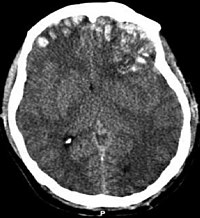
Proprioceptive contribution to oculomotor control in humans
Sign Up to like & getrecommendations! Published in 2022 at "Human Brain Mapping"
DOI: 10.1002/hbm.26080
Abstract: Stretch receptors in the extraocular muscles (EOMs) inform the central nervous system about the rotation of one's own eyes in the orbits. Whereas fine control of the skeletal muscles hinges critically on proprioceptive feedback, the… read more here.
Keywords: oculomotor; oculomotor control; control; eye ... See more keywords

Ataxia with Oculomotor Apraxia Type 1—New Mutation, Characteristic Phenotype
Sign Up to like & getrecommendations! Published in 2019 at "Movement Disorders Clinical Practice"
DOI: 10.1002/mdc3.12725
Abstract: A 22-year-old man is the third of four siblings from a family with a high degree of consanguinity. At 18 months, he was first noted to be unsteady and subsequently developed a slurred speech. His… read more here.
Keywords: head; apraxia type; ataxia oculomotor; oculomotor apraxia ... See more keywords

Eye Movement Disorders in Movement Disorders
Sign Up to like & getrecommendations! Published in 2022 at "Movement Disorders Clinical Practice"
DOI: 10.1002/mdc3.13413
Abstract: Oculomotor assessment is an essential element of the neurological clinical examination and is particularly important when evaluating patients with movements disorders. Most of the brain is involved in oculomotor control, and thus many neurological conditions… read more here.
Keywords: movement disorders; oculomotor; movement; eye movement ... See more keywords

Clinical and Genetic Characterization of Brazilian Patients with Ataxia and Oculomotor Apraxia
Sign Up to like & getrecommendations! Published in 2022 at "Movement Disorders"
DOI: 10.1002/mds.29015
Abstract: Ataxia with oculomotor apraxia (AOA) is characterized by early‐onset cerebellar ataxia associated with oculomotor apraxia. AOA1, AOA2, AOA3, and AOA4 subtypes may present pathogenic variants in APTX, SETX, PIK3R5, and PNKP genes, respectively. Mutations in… read more here.
Keywords: oculomotor; characterization brazilian; ataxia oculomotor; genetic characterization ... See more keywords

Isolated pseudoabducens palsy in acute thalamic stroke.
Sign Up to like & getrecommendations! Published in 2017 at "Clinical imaging"
DOI: 10.1016/j.clinimag.2017.01.013
Abstract: Oculomotor abnormalities are rarely noted in thalamic strokes. We describe isolated right pseudoabducens palsy in a young patient with acute left thalamic infarction revealed by diffusion-weighted magnetic resonance imaging. The patient's horizontal diplopia and oculomotor… read more here.
Keywords: thalamic stroke; isolated pseudoabducens; pseudoabducens palsy; oculomotor ... See more keywords

Oculomotor feedback rapidly reduces overt attentional capture
Sign Up to like & getrecommendations! Published in 2021 at "Cognition"
DOI: 10.1016/j.cognition.2021.104917
Abstract: People often have limited awareness of the extent to which their attention is captured by salient-but-irrelevant stimuli. In the present study, we examined how providing feedback concerning the frequency of oculomotor capture by such stimuli… read more here.
Keywords: oculomotor feedback; frequency; feedback; oculomotor capture ... See more keywords

Microsaccades inhibition triggered by a repetitive visual distractor is not subject to habituation: Implications for the programming of reflexive saccades
Sign Up to like & getrecommendations! Published in 2020 at "Cortex"
DOI: 10.1016/j.cortex.2020.07.013
Abstract: The oculomotor capture triggered by a peripheral onset is subject to habituation, a basic form of learning consisting in a response decrement toward a repeatedly presented stimulus. However, it is unclear whether habituation of reflexive… read more here.
Keywords: reflexive saccades; subject habituation; habituation; stage ... See more keywords

Attention capture outside the oculomotor range
Sign Up to like & getrecommendations! Published in 2020 at "Current Biology"
DOI: 10.1016/j.cub.2020.09.054
Abstract: Neurophysiological studies have demonstrated that attentional orienting is associated with activity in fronto-parietal brain areas that play a pivotal role in oculomotor control, such as the lateral intraparietal cortex (LIP), the frontal eye fields (FEF),… read more here.
Keywords: exogenous attention; outside oculomotor; attention; oculomotor range ... See more keywords
Visualization and quantification of eye tracking data for the evaluation of oculomotor function
Sign Up to like & getrecommendations! Published in 2019 at "Heliyon"
DOI: 10.1016/j.heliyon.2019.e01127
Abstract: Oculomotor dysfunction may originate from physical, physiological or psychological causes and may be a marker for schizophrenia or other disorders. Observational tests for oculomotor dysfunction are easy to administer, but are subjective and transient, and… read more here.
Keywords: quantification eye; visualization quantification; eye tracking; oculomotor ... See more keywords

Isolate unilateral oculomotor palsy after mild traumatic brain injury.
Sign Up to like & getrecommendations! Published in 2018 at "Neurocirugia"
DOI: 10.1016/j.neucir.2018.05.005
Abstract: Isolated traumatic oculomotor nerve (ON) palsy is an uncommon clinical presentation of mild traumatic brain injury (TBI). There are very few cases in which it has been possible to demonstrate the isolated damage of the… read more here.
Keywords: traumatic brain; palsy; mild traumatic; brain injury ... See more keywords

The Resolution of Oculomotor Nerve Palsy Caused by Unruptured Posterior Communicating Artery Aneurysms: A Cohort Study and Narrative Review.
Sign Up to like & getrecommendations! Published in 2017 at "World neurosurgery"
DOI: 10.1016/j.wneu.2017.07.123
Abstract: OBJECTIVE Recovery of oculomotor nerve palsy after microsurgical and endovascular treatment has been studied in numerous small series of predominantly ruptured aneurysms. Little consideration has been given to the distinction between ruptured and unruptured aneurysms.… read more here.
Keywords: nerve palsy; posterior communicating; palsy; communicating artery ... See more keywords